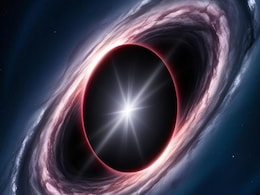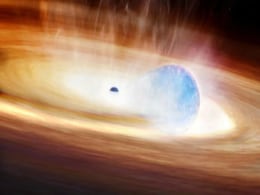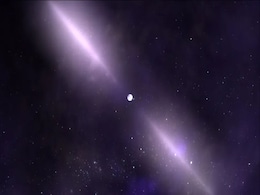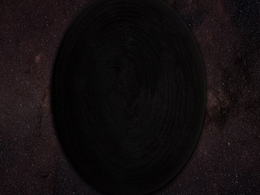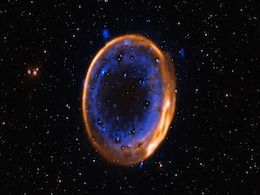Astronomy And Astrophysics
- All
- News
- Videos
-

NASA's IXPE Solves Long-Standing Mystery Behind Black Hole Jets
- Thursday December 18, 2025
- Science |
NASA's IXPE mission has identified how X-rays are produced in the jet of a supermassive black hole, confirming that they originate from the same jet through synchrotron self-Compton scattering and resolving a long-standing question in X-ray astronomy
-
 www.ndtv.com
www.ndtv.com
-

Astronomers Witness Longest-Lasting Gamma-Ray Burst in History, 8 Billion Light-Years Away
- Tuesday December 16, 2025
A gamma-ray burst lasting over seven hours was recorded 8 billion light-years away, revealing a rare type of cosmic explosion and challenging current astrophysics models.
-
 www.gadgets360.com
www.gadgets360.com
-

Chandra’s New X-Ray Mapping Exposes the Invisible Engines Powering Galaxy Clusters
- Friday December 12, 2025
NASA’s Chandra X-ray Observatory has released stunning colour-coded galaxy cluster images that reveal shock waves, cooling gas, and cavities carved by supermassive black holes. By separating X-ray light into different energy bands, astronomers can now visualise hidden cosmic processes that shape the universe’s largest structures and control how...
-
 www.gadgets360.com
www.gadgets360.com
-

Astronomers Uncover the Vast Greater Pleiades Complex with 3,000 Hidden Stars
- Monday November 17, 2025
Astronomers analyzing Gaia and TESS data have discovered that the famed Pleiades is only the bright center of a much larger stellar complex containing over 3,000 stars. Spanning 2,000 light-years, this vast family reveals how young clusters form, travel, and disperse across the galaxy.
-
 www.gadgets360.com
www.gadgets360.com
-

Mystery Deepens as Interstellar Comet 3I/ATLAS Brightens Unexpectedly Near the Sun
- Thursday November 6, 2025
Interstellar comet 3I/ATLAS defied expectations during its 2025 solar flyby, brightening far faster than predicted. Observatories worldwide recorded a blue coma rich in exotic gases, suggesting unique chemistry from another star system. Scientists are investigating whether its unusual composition or speed caused the outburst, marking a new interste...
-
 www.gadgets360.com
www.gadgets360.com
-

Dark Matter May Behave Like Ordinary Matter Under Gravity, New Study Finds
- Tuesday November 4, 2025
A new study shows dark matter falls into cosmic gravity wells much like ordinary matter, narrowing one of astronomy’s biggest mysteries. Researchers say any unknown force acting on dark matter must be very weak, though future missions could detect smaller effects. The findings bring scientists closer to understanding how the universe’s unseen m...
-
 www.gadgets360.com
www.gadgets360.com
-

Keio University Team Measures Ancient Cosmic Temperature, Confirming Big Bang Prediction
- Tuesday November 4, 2025
Using ALMA, Keio University scientists measured a 5.13 K cosmic background temperature from 7 billion years ago—matching Big Bang predictions of universal cooling. This precise reading, based on quasar absorption data, is the most accurate at that epoch and offers strong confirmation of how the Universe’s temperature decreases over time.
-
 www.gadgets360.com
www.gadgets360.com
-

LIGO Detect Possible Second-Generation Black Holes with Extreme Spins
- Sunday November 2, 2025
LIGO-Virgo-KAGRA observatories detected two extraordinary black hole collisions in late 2024—GW241011 and GW241110. The first involved a rapidly spinning black hole, while the second revealed one rotating opposite its orbit. These findings fit predictions for second-generation black holes, born from earlier mergers within crowded star clusters. T...
-
 www.gadgets360.com
www.gadgets360.com
-

James Webb Telescope Finds Early Universe Galaxies Were More Chaotic Than We Thought
- Thursday October 23, 2025
The James Webb Space Telescope has revealed that galaxies in the early universe were far more chaotic and unstable than once believed. A new study shows that gas turbulence and intense star formation disrupted young galaxies, reshaping scientists’ understanding of how galaxies evolved into the structured systems seen today.
-
 www.gadgets360.com
www.gadgets360.com
-

Scientists Recreate Universe’s First Molecules, Challenging Early Star Formation Theories
- Tuesday August 19, 2025
Scientists have recreated helium hydride ions, the universe’s first molecules, under lab conditions. The study reveals these ions were far more effective in driving early star formation than older theories suggested. Published in Astronomy and Astrophysics, the research reshapes understanding of early cosmic chemistry and challenges assumptions a...
-
 www.gadgets360.com
www.gadgets360.com
-

Scientists Apply Stephen Hawking's Theory to Propose Detectable ‘Black Hole Morsels’ in Space
- Thursday August 14, 2025
A new study suggests “black hole morsels” — tiny, asteroid-sized black holes from cosmic mergers — could emit detectable bursts of Hawking radiation. Observatories like HESS, HAWC, and Fermi may already hold clues. Detecting them could unlock insights into quantum gravity, unknown particles, and even hidden dimensions beyond the Standard Mo...
-
 www.gadgets360.com
www.gadgets360.com
-

Astronomers Observe Rare Supernova–Black Hole Interaction in Early Stages
- Sunday August 17, 2025
In a groundbreaking discovery, astronomers observed SN 2023zkd, a supernova that may have been triggered by close interaction with a black hole. Featuring unusual brightness peaks and extended pre-explosion activity, the event offers new insights into star black hole dynamics. Real-time AI detection played a key role, and upcoming surveys promise t...
-
 www.gadgets360.com
www.gadgets360.com
-

PSR J0922+0638 Pulsar Keeps Glitching Every 550 Days, Scientists Are Intrigued
- Thursday July 31, 2025
PSR J0922+0638, an ultradense neutron star, shows puzzling rotational glitches every 550 days. Using 22 years of radio data, scientists detected both abrupt and slow changes in its spin. These may be linked to magnetic field cycles or superfluid dynamics deep inside the star. However, the exact cause remains a mystery, demanding continued long-term...
-
 www.gadgets360.com
www.gadgets360.com
-

Scientists Say Dark Matter Could Turn Failed Stars Into ‘Dark Dwarfs’
- Friday July 11, 2025
Astronomers suggest that brown dwarfs—dim, failed stars—could transform into “dark dwarfs” by capturing dark matter in their cores. When dark matter particles annihilate, they release heat, potentially lighting up these stars. Physicist Jeremy Sakstein and researchers like Jillian Paulin and Rebecca Leane support this idea, which could help...
-
 www.gadgets360.com
www.gadgets360.com
-

Astronomers Capture First-Ever Image of a Dead Star That Exploded Twice in Rare Supernova Event
- Saturday July 5, 2025
Astronomers have captured the first-ever image of a white dwarf star undergoing a rare double-detonation supernova. Using the Very Large Telescope, the team revealed that such explosions can occur without a star reaching the Chandrasekhar limit. The findings, published in Nature Astronomy, could reshape existing theories about stellar death and imp...
-
 www.gadgets360.com
www.gadgets360.com
-

NASA's IXPE Solves Long-Standing Mystery Behind Black Hole Jets
- Thursday December 18, 2025
- Science |
NASA's IXPE mission has identified how X-rays are produced in the jet of a supermassive black hole, confirming that they originate from the same jet through synchrotron self-Compton scattering and resolving a long-standing question in X-ray astronomy
-
 www.ndtv.com
www.ndtv.com
-

Astronomers Witness Longest-Lasting Gamma-Ray Burst in History, 8 Billion Light-Years Away
- Tuesday December 16, 2025
A gamma-ray burst lasting over seven hours was recorded 8 billion light-years away, revealing a rare type of cosmic explosion and challenging current astrophysics models.
-
 www.gadgets360.com
www.gadgets360.com
-

Chandra’s New X-Ray Mapping Exposes the Invisible Engines Powering Galaxy Clusters
- Friday December 12, 2025
NASA’s Chandra X-ray Observatory has released stunning colour-coded galaxy cluster images that reveal shock waves, cooling gas, and cavities carved by supermassive black holes. By separating X-ray light into different energy bands, astronomers can now visualise hidden cosmic processes that shape the universe’s largest structures and control how...
-
 www.gadgets360.com
www.gadgets360.com
-

Astronomers Uncover the Vast Greater Pleiades Complex with 3,000 Hidden Stars
- Monday November 17, 2025
Astronomers analyzing Gaia and TESS data have discovered that the famed Pleiades is only the bright center of a much larger stellar complex containing over 3,000 stars. Spanning 2,000 light-years, this vast family reveals how young clusters form, travel, and disperse across the galaxy.
-
 www.gadgets360.com
www.gadgets360.com
-

Mystery Deepens as Interstellar Comet 3I/ATLAS Brightens Unexpectedly Near the Sun
- Thursday November 6, 2025
Interstellar comet 3I/ATLAS defied expectations during its 2025 solar flyby, brightening far faster than predicted. Observatories worldwide recorded a blue coma rich in exotic gases, suggesting unique chemistry from another star system. Scientists are investigating whether its unusual composition or speed caused the outburst, marking a new interste...
-
 www.gadgets360.com
www.gadgets360.com
-

Dark Matter May Behave Like Ordinary Matter Under Gravity, New Study Finds
- Tuesday November 4, 2025
A new study shows dark matter falls into cosmic gravity wells much like ordinary matter, narrowing one of astronomy’s biggest mysteries. Researchers say any unknown force acting on dark matter must be very weak, though future missions could detect smaller effects. The findings bring scientists closer to understanding how the universe’s unseen m...
-
 www.gadgets360.com
www.gadgets360.com
-

Keio University Team Measures Ancient Cosmic Temperature, Confirming Big Bang Prediction
- Tuesday November 4, 2025
Using ALMA, Keio University scientists measured a 5.13 K cosmic background temperature from 7 billion years ago—matching Big Bang predictions of universal cooling. This precise reading, based on quasar absorption data, is the most accurate at that epoch and offers strong confirmation of how the Universe’s temperature decreases over time.
-
 www.gadgets360.com
www.gadgets360.com
-

LIGO Detect Possible Second-Generation Black Holes with Extreme Spins
- Sunday November 2, 2025
LIGO-Virgo-KAGRA observatories detected two extraordinary black hole collisions in late 2024—GW241011 and GW241110. The first involved a rapidly spinning black hole, while the second revealed one rotating opposite its orbit. These findings fit predictions for second-generation black holes, born from earlier mergers within crowded star clusters. T...
-
 www.gadgets360.com
www.gadgets360.com
-

James Webb Telescope Finds Early Universe Galaxies Were More Chaotic Than We Thought
- Thursday October 23, 2025
The James Webb Space Telescope has revealed that galaxies in the early universe were far more chaotic and unstable than once believed. A new study shows that gas turbulence and intense star formation disrupted young galaxies, reshaping scientists’ understanding of how galaxies evolved into the structured systems seen today.
-
 www.gadgets360.com
www.gadgets360.com
-

Scientists Recreate Universe’s First Molecules, Challenging Early Star Formation Theories
- Tuesday August 19, 2025
Scientists have recreated helium hydride ions, the universe’s first molecules, under lab conditions. The study reveals these ions were far more effective in driving early star formation than older theories suggested. Published in Astronomy and Astrophysics, the research reshapes understanding of early cosmic chemistry and challenges assumptions a...
-
 www.gadgets360.com
www.gadgets360.com
-

Scientists Apply Stephen Hawking's Theory to Propose Detectable ‘Black Hole Morsels’ in Space
- Thursday August 14, 2025
A new study suggests “black hole morsels” — tiny, asteroid-sized black holes from cosmic mergers — could emit detectable bursts of Hawking radiation. Observatories like HESS, HAWC, and Fermi may already hold clues. Detecting them could unlock insights into quantum gravity, unknown particles, and even hidden dimensions beyond the Standard Mo...
-
 www.gadgets360.com
www.gadgets360.com
-

Astronomers Observe Rare Supernova–Black Hole Interaction in Early Stages
- Sunday August 17, 2025
In a groundbreaking discovery, astronomers observed SN 2023zkd, a supernova that may have been triggered by close interaction with a black hole. Featuring unusual brightness peaks and extended pre-explosion activity, the event offers new insights into star black hole dynamics. Real-time AI detection played a key role, and upcoming surveys promise t...
-
 www.gadgets360.com
www.gadgets360.com
-

PSR J0922+0638 Pulsar Keeps Glitching Every 550 Days, Scientists Are Intrigued
- Thursday July 31, 2025
PSR J0922+0638, an ultradense neutron star, shows puzzling rotational glitches every 550 days. Using 22 years of radio data, scientists detected both abrupt and slow changes in its spin. These may be linked to magnetic field cycles or superfluid dynamics deep inside the star. However, the exact cause remains a mystery, demanding continued long-term...
-
 www.gadgets360.com
www.gadgets360.com
-

Scientists Say Dark Matter Could Turn Failed Stars Into ‘Dark Dwarfs’
- Friday July 11, 2025
Astronomers suggest that brown dwarfs—dim, failed stars—could transform into “dark dwarfs” by capturing dark matter in their cores. When dark matter particles annihilate, they release heat, potentially lighting up these stars. Physicist Jeremy Sakstein and researchers like Jillian Paulin and Rebecca Leane support this idea, which could help...
-
 www.gadgets360.com
www.gadgets360.com
-

Astronomers Capture First-Ever Image of a Dead Star That Exploded Twice in Rare Supernova Event
- Saturday July 5, 2025
Astronomers have captured the first-ever image of a white dwarf star undergoing a rare double-detonation supernova. Using the Very Large Telescope, the team revealed that such explosions can occur without a star reaching the Chandrasekhar limit. The findings, published in Nature Astronomy, could reshape existing theories about stellar death and imp...
-
 www.gadgets360.com
www.gadgets360.com











